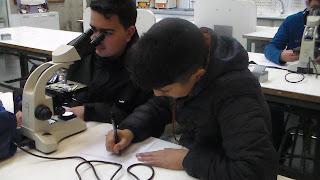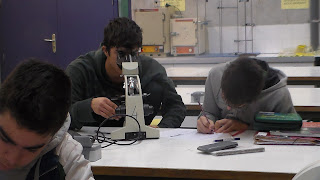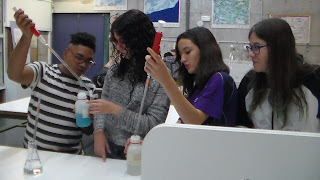Today we haver started to design posters about the circulatory system.
Each topic covers an area of the circulatory system: blood, blood vessels, the heart and the circuits.
Did you know that if you were to lay out all of the arteries, capillaries and veins in one adult, end-to-end, they would stretch about 100,000 kilometers?
12/10/2015
12/09/2015
Energy transfer and storage
Today we have been reviewing concepts for the exam and revising definitions related to concepts of energy transfer and storage.
12/03/2015
Observing blood samples
Today we have been talking about the different components of blood and checking some samples with a microscope.
Did you know that adults have about three liters of plasma in their blood?
Did you know that adults have about three liters of plasma in their blood?
11/25/2015
Checking the Archimedes' Principle
Today we have been working on a lab practice to check the validity of the Archimedes' principle.
Did you know that he could work out the density (or specific gravity) of an object by comparing the object’s weight to the weight of water it pushes out of a jar when completely it was submerged?
11/19/2015
The role of saliva in digestion (part 2)
Today we have finished the lab practice to find out if saliva in involved with digestion.
Did you know that saliva contains amylase, an enzyme which helps break down starch and turn it into glucose?
11/18/2015
Kinetic energy versus potential energy
Today we have worked with the concepts of potential energy and kinetic energy. We have used a set of formulas to calculate each.
Did you know that energy is measured with Joules? They are named after Sir James Prescott Joule.
11/12/2015
The role of saliva in digestion (part 1)
Saliva is very important for digestion. Today we have done a lab practice to understand how saliva helps break down polysaccharides into monosaccharides.
Did you know that Lugol's iodine is very helpful to detect starch and Fehline's solution can help you to detect glucose?
10/29/2015
Observing human tissue
Today we have observed human tissue on the microscope to identify its structures. This time we have worked with samples from our oral mucosa and we have observed them at different magnifications.
Did you know that methylene blue helps us see the cells on the microscope better because it stains them?
Labels:
Biology & Geology
Location:
Igualada, Barcelona, España
10/28/2015
Archimedes' principle review
Today we have been reviewing the Archimedes' principle and applying formulas related to the forces of upthrust and weight.
Did you know that ships float because the boat is less dense than the water, so it displaces a mass equal to its own instead of sinking?
10/22/2015
Parts of the microscope
Today we have checked the parts of the microscope and we have had time to look at some samples.
Did you know that the earliest microscopes were called "flea glasses" because they were used to study small insects?
10/21/2015
The Archimedes' Principle
Today we have worked with the Archimedes principle. We have been completing the dossiers and we have practiced the concepts of upthrust and weight as forces that act on bodies when they are immersed in fluids.
Did you know that Archimedes got his idea while bathing?
10/14/2015
Calculating Weight
In this practice, we have tested the formula Weight = mass x gravitational acceleration, and we have represented the results in a graph.
While the results did not match with perfect exactitude, the results point out that there is correlation.
10/08/2015
Athletes & Food
Today students have become teachers and have dictated each other information about the differences between the diet of a normal person and the diet of an athlete.
Did you know that, on average, men require about 10,000 kilojoules a day while women require between 8,000 and 8,500?
10/07/2015
Measuring forces
Today we have started to work with dynamometers to measure weight and electronic balances to measure mass.
We are getting familiar with how these devices work and how they can be useful to measure forces.
By the way, did you know that the average value of gravity on Earth is 9.8 m/s²?
Welcome!
Welcome to the Science blog for Institut Joan Mercader!
This course 2015-2016, we are going to show you some of the activities we do in the classroom.
We hope you enjoy it! :)
This course 2015-2016, we are going to show you some of the activities we do in the classroom.
We hope you enjoy it! :)
Subscribe to:
Posts (Atom)













































